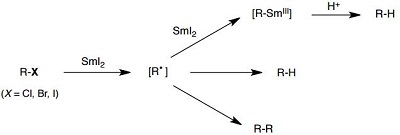Reaction
SmI2 has been used extensively in literature due to its large reduction potential. Known as a single-electron transfer reagent.

Mechanism of SmI2-mediated Reactions
Radicals and anions from organohalides

Reduction of halides: iodides > bromides > chloride

reaction carried out at 60 °C
Description
Samarium(II) iodide, SmI2, when employed as a solution for organic synthesis, is known as “Kagan’s reagent.” SmI2 is a green solid and its solutions are green as well. It is a strong one-electron reducing agent that is used in organic synthesis. Solid, solvent-free SmI2 forms by high-temperature decomposition of samarium(III) iodide (SmI3).
Chemical Properties
Deep bleu-green solution
Uses
Samarium(II) iodide solution (SmI
2) can be used as a reagent in the synthesis of:
- Benzannulated pyrrolizidines and indolizidines by SmI2-induced cyclizations of indole derivatives.
- Chiral 4-substituted 2-oxazolidinones and 5,5-disubstituted oxazolidinones through asymmetric Reformatsky type reaction.
- γ-Aminoalkyl substituted γ-butyrolactones via ketyl-alkene coupling reaction.
It can also be used in:
- Reduction of conjugated double and triple bonds into alkenes using SmI2/H2O/amine mixtures.
- Conversion of β-hydroxyketones into 1,3-diols by SmI2/H2O/Et3N.
- Selective reduction of 6-membered lactones to the corresponding diols/triols using SmI2-H2O reagent system.
SmI
2 is an effective single-electron reducing agent for the promotion of ketone-olefin, ketyl aryl cyclizations, and pinacol coupling reactions under mild conditions. Often both intramolecular and intermolecular couplings proceed in a highly stereoselective fashion. It is also used in the synthesis of new heteroleptic samarium aryloxide/cyclopentadienide complexes.
Uses
In organic synthesis and electron transfer reactions; in discharge lamps.
reaction suitability
reagent type: catalyst
core: samarium
reagent type: reductant
Purification Methods
A possible impurity is SmI3 from which it is made. If present, grind the solid to a powder and heat it in a stream of pure H2. The temperature (~ 500-600o) should be below the m (~ 628o) of SmI3, since the molten compounds react very slowly. [Wetzel in Handbook of Preparative Inorganic Chemistry (Ed. Brauer) Academic Press Vol II pp 1149, 1150 1965.]








